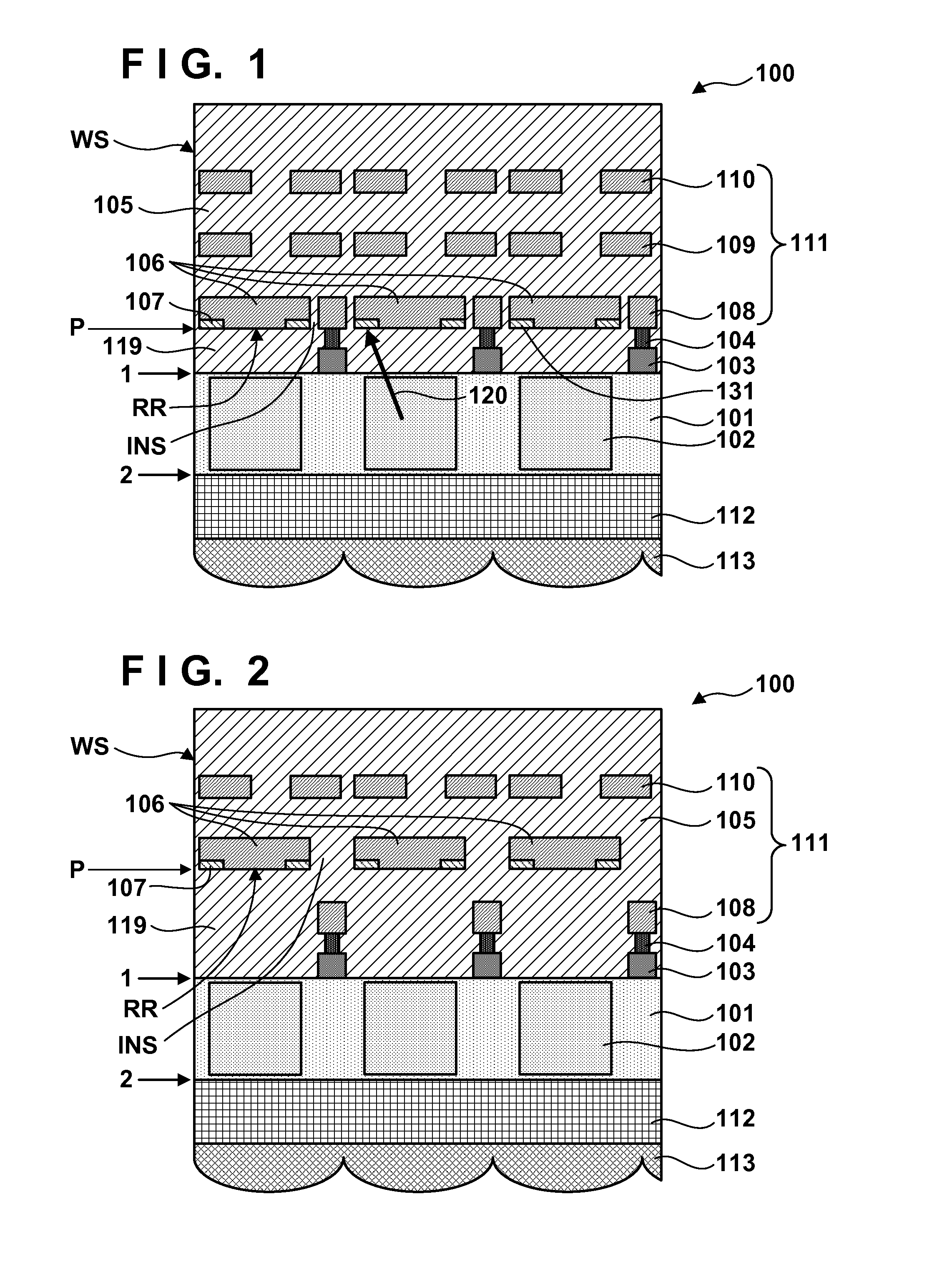Solid-state image sensor, method of manufacturing the same and camera
a technology of solid-state image sensor and manufacturing method, which is applied in the direction of color television, color television, television system scanning details, etc., can solve problems such as color mixing, and achieve the effect of reducing color mixing
- Summary
- Abstract
- Description
- Claims
- Application Information
AI Technical Summary
Benefits of technology
Problems solved by technology
Method used
Image
Examples
first embodiment
[0024]FIG. 1 schematically shows the sectional structure of a solid-state image sensor 100 according to the present invention. Note that FIG. 1 shows only three pixels but the solid-state image sensor 100 can include a larger number of pixels. The solid-state image sensor 100 can include a semiconductor layer 101 having a first face 1 and second face 2, a plurality of photoelectric converters 102 two-dimensionally arranged in the semiconductor layer 101, and a wiring structure WS arranged on the side of the first face 1. The solid-state image sensor 100 is configured so that light from an object is incident on the second face 2 through an imaging lens. That is, the solid-state image sensor 100 is formed as a back-side illumination solid-state image sensor in which a wiring structure is arranged on the side of the first face of a semiconductor layer and light from an object is incident on the second face of the semiconductor layer. A plurality of microlenses 113 can be typically arra...
second embodiment
[0047]In the second embodiment, it is possible to improve the degree of freedom of wiring by forming each reflection portion 106 as part of a wiring pattern for communicating an electric signal. Each reflection portion 106 may be formed as part of a wiring pattern for communicating an electric signal in a wiring layer other than a wiring layer 108 of a first layer, for example, a wiring layer 109 of a second layer or a wiring layer 110 of a third layer.
[0048]A solid-state image sensor 100 according to the third embodiment of the present invention will be described below with reference to FIGS. 6A and 6B. Note that points not mentioned in the third embodiment can comply with at least one of the first and second embodiments.
[0049]A plurality of photoelectric converters 102 include a first photoelectric converter 102 on which light of a first wavelength range is incident, a second photoelectric converter 102 on which light of a second wavelength range is incident, and a third photoelec...
third embodiment
[0052]The third embodiment is useful when the layouts of a plurality of pixels are different from each other, and it is difficult to provide reflection portions 106 and light absorbing portions 107 in all the pixels, for example, when a plurality of photoelectric converters 102 share a floating diffusion.
[0053]A solid-state image sensor 100 according to the fourth embodiment of the present invention will be described below with reference to FIGS. 7 to 11B. Note that points not mentioned in the fourth embodiment can comply with at least one of the first to third embodiments. In the solid-state image sensor 100 according to the fourth embodiment, the relative position between a photoelectric converter 102 and a corresponding reflection region RR and light absorbing portion 107 is determined depending on the position of the photoelectric converter 102 in a semiconductor layer 101.
[0054]When the position of the photoelectric converter 102 in the semiconductor layer 101 changes, the dire...
PUM
 Login to View More
Login to View More Abstract
Description
Claims
Application Information
 Login to View More
Login to View More - R&D
- Intellectual Property
- Life Sciences
- Materials
- Tech Scout
- Unparalleled Data Quality
- Higher Quality Content
- 60% Fewer Hallucinations
Browse by: Latest US Patents, China's latest patents, Technical Efficacy Thesaurus, Application Domain, Technology Topic, Popular Technical Reports.
© 2025 PatSnap. All rights reserved.Legal|Privacy policy|Modern Slavery Act Transparency Statement|Sitemap|About US| Contact US: help@patsnap.com



